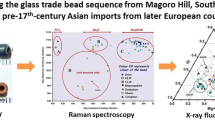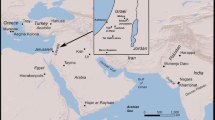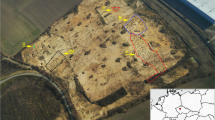Abstract
The archaeological record of beads from eastern India has been sketchy and unstandardized. Here, an attempt is made to present a cohesive picture emphasizing regional patterns and preferences. When possible, glass beads are chronologically situated on the basis of excavated sites with firm chronological sequence. A general distribution of the beads is given according to colour, shape and manufacturing method when available. It appears from the current dataset that there is a distinction between the coastal sites and the inland sites. While the inland areas have more of green and blue glass, the coastal area has opaque red, yellow and orange. The barrel shapes predominate but an important proportion of cylinder circular and disc beads was also noted. In contrast, facetted beads are few. An interesting feature for eastern India is the presence of two types of composite glass bead that tend to imitate agate.
Access this chapter
Tax calculation will be finalised at checkout
Purchases are for personal use only
Similar content being viewed by others
Notes
- 1.
The Kushana kingdom dates from c. CE 30 to c. CE 375, until the invasions of the Kidarites. They ruled around the same time as the Western Satraps, the Satavahanas, and the first Gupta Empire rulers.
- 2.
Pearson’s correlation coefficient is a technique for investigating the relationship between quantitative and continuous variables.
References
Altekar, A. S., & Mishra, V. (1959). Report on Kumrahar Excavation 1951–55. Historical Research Series vol. III. K.V. Jayaswal Research Institute.
Beck, H. C. (1928). Classification and nomenclature of beads and pendants. Society of Antiquaries.
Boussac, M. -F., & Alam, Md. S. (2001). Beads. In Md. S. Alam, & J. -F. Salles (Eds.), France-Bangladesh joint Venture Excavations at Mahasthan: First Interim Report 1993–1999 (pp. 427–495). Department of Archaeology, Ministry of Cultural Affairs, Government of the People’s Republic of Bangladesh and Mission Francaise de coopération archéologique au Bangladesh, Maison de I’Orient Méditerranéen- Jean Pouilloux, Lyon, Ministry of Foreign Affairs.
Breuil, J. -Y., Salles J. -F., Rahman Md. H., & Shafikul, Md. A., (2001). Radiocarbon Dates from Mahasthan. In Md. S. Alam, & J. -F. Salles (Eds.), France-Bangladesh joint Venture Excavations at Mahasthan: First Interim Report 1993–1999 (pp. 219–228). Department of Archaeology, Ministry of Cultural Affairs, Government of the People’s Republic of Bangladesh and Mission Française de coopération archéologique au Bangladesh, Maison de I’Orient Méditerranéen- Jean Pouilloux, Lyon, Ministry of Foreign Affairs.
Chakraborty, S. (2000). Chandraketugarh: An archaeological and cultural study (500BC to 500AD). PhD Thesis. Pune: Deccan College Post-Graduate & Research Institute.
Deva, K., & Mishra, V. (1961). Vaishali excavation. Vaishali Sangh.
Francis, P., Jr. (2000–2001). The Stone bead industry of South India. Beads: Journal of the Society of Bead Researchers 12–13, 49–62.
Francis, P., Jr. (2004). Beads and selected small finds from the 1989–92 Excavation. In V. Begley, P. Francis Jr., N. Karashima, S.E. Sidibotham, & E.L. Will (Eds.), Ancient port of Arikamedu: New excavations and researches 1989–92 (pp. 447–604). Mémoires Archéologiques 22.2. Ecole Française d’Extrême-Orient.
Gangopadhyay, K. (2003). Archaeology of early historic period in coastal West Bengal with special reference to Medinipur district. PhD Thesis. Bhubaneswar: Utkal University.
Goswami, K. G. (1948). Excavation at Bangarh 1938–41. Calcutta: Asutosh Museum Memoir 1.
Gratuze, B., Lankton, J., Islam, Md. S., & Boussac, M.-F. (2015). Glass beads of Mahasthan: Evidence for production and exchange. In Mahasthan II Fouilles du Rampart Est: Études Archéologiques under the direction of Jean François Salles. Brepol Publishers Turnhout.
Haque, E., Rahman, S. S. M., & Ahsan, S. M. K. (2001). A preliminary report on Wari Bateswar trial excavation by ICSBA. In E. Haque (Ed.), Excavation at Wari-Bateswar: A preliminary study (pp. 11–41). The International Centre for the Study of Bengal Art.
Hartel, H. (1993). Excavation at Sonkh, 2500 years of a town in Mathura district. Dietrich Reimar Verlag.
Kanungo, A. K. (2013). Glass beads & bangles from Kopia. In A. K. Kanungo (Ed.) Glass in Ancient India: Excavations at Kopia. Kerala Council for Historical Research
Kanungo, A. K. (2019). Chevron and Millefiori in India. Journal of the Borneo International Beads Conference, 2019, 69–88.
Rahman, S. S. M. (2003). Wari Batesware Prapta Kancher Punti: Ekti Pratnatattvik Samiksha (in Bengali). Pratnatattva, 9, 1–10.
Sinha, B. P., & Roy, S. R. (1969). Vaisali Excavation 1958–62. Patna: Directorate of Archaeological Museum Bihar.
Sinha, B. P., & Verma, B. S. (1977). Sonpur Excavation 1956 and 1959–62. Patna: Directorate of Archaeology and Museum Bihar.
Verma, B. S. (2007). Chirand Excavation Report: 1961–1964 and 1967–1970. Patna: Directorate of Archaeology (Department of Youth and Cultural Affairs, Govt. of Bihar).
Acknowledgements
I thank IIT Gandhinagar for giving me an opportunity to take a fresh look at the glass beads; Piyali Sengupta, Director DAWB, for permitting me to study beads in their collection; Chinmay Kulkarni, IITGN for making the Map (Fig. 2); Dr. Sharmila Saha and Sumita Guha for their help.
Author information
Authors and Affiliations
Editor information
Editors and Affiliations
Rights and permissions
Copyright information
© 2021 The Author(s), under exclusive license to Springer Nature Singapore Pte Ltd.
About this chapter
Cite this chapter
Chakraborty, S. (2021). Glass Beads of Eastern India (Early Historic Period). In: Kanungo, A.K., Dussubieux, L. (eds) Ancient Glass of South Asia. Springer, Singapore. https://doi.org/10.1007/978-981-16-3656-1_13
Download citation
DOI: https://doi.org/10.1007/978-981-16-3656-1_13
Published:
Publisher Name: Springer, Singapore
Print ISBN: 978-981-16-3655-4
Online ISBN: 978-981-16-3656-1
eBook Packages: HistoryHistory (R0)




